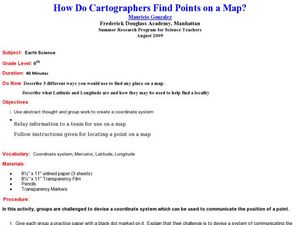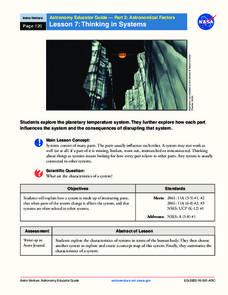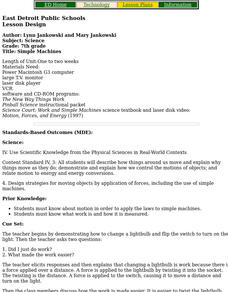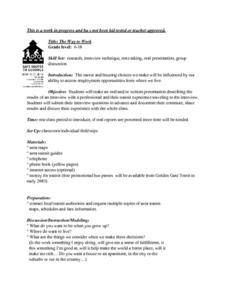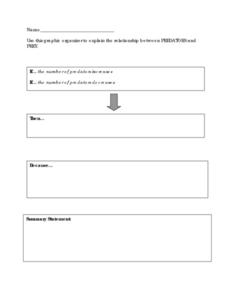Curated OER
How Do Cartographers Find Points on a Map?
Ninth graders describe latitude and longitude and how they may be useful to find things on a map. In this cartography lesson students divide into groups and devise a coordinate system that can be used to communicate a position.
Power to Learn
How Much Space Do We Have?
Census-takers view the Internet to find the total population of a city and its total land area. They work with different mathematical scenarios that involve populations and land area in their city. They complete math problems and unit...
Curated OER
Helping Ourselves: Why Philanthropy Works
Students discover the concept of philanthropy. In this civics lesson, students investigate the role of philanthropy in our society, and how it makes life better for all.
Curated OER
Working Animals
Students discuss the role of animals and how they can work with people to better the community. In this working animals lesson plan, students discuss how animals and people work together to complete different tasks in the community.
NASA
Astronomy Mission Module
Yes, scientists say, there is other life in our solar system! And the best place to look is on Europa, a moon of Jupiter. Here, learners mimic the techniques scientists use to gather information about objects in our solar system, write...
Inside Mathematics
Graphs (2007)
Challenge the class to utilize their knowledge of linear and quadratic functions to determine the intersection of the parent quadratic graph and linear proportional graphs. Using the pattern for the solutions, individuals develop a...
Turabian Teacher Collaborative
My Favorite Martian: Workshopping Warrants
Sometimes explaining an argument can lead to confusion and miscommunication. Narrow down the details in written arguments with a group activity in which learners pretend to be aliens from another planet, struggling to understand each...
Curated OER
Indianapolis 500 Unit-Science
Fourth graders access prior knowledge of simple machines to build a car. In this car design lesson, 4th graders create and race their cars. Students evaluate what was good and bad about their designs. Each car will incorporate a simple...
Alabama Learning Exchange
Classification
Learners examine why scientists classify living organisms. They list and classify items they buy at the grocery store, sort and classify leaves, explore various websites, and write a biography of Carolus Linnaeus.
Curated OER
Hot Air Balloons
Students examine how a hot air balloon works. In this hot air balloon lesson, students do an experiment to test the effects of heat on density. Students make their own hot air balloon and act out how nitrogen moves when turned to a liquid.
Curated OER
Looking into Space
Students explain how telescopes work and how they can contribute to our knowledge of the universe.
Curated OER
The Way to Work
Students make oral and/or written presentations describing results of interviews with professionals and their transit experiences traveling to the interviews.
Curated OER
Night Hike
Students explore Upham Woods at night and investigate about the special adaptations of nocturnal animals. They identify three nocturnal animals and how they are adapted to the night. Students explain what night vision is and how it works.
Curated OER
Everything's Connected
Learners explore how trash decomposes. In this ecosystem lesson, students discuss new vocabulary words, such as producers and consumers, and think critically to answer how landfills work.
Curated OER
The World of Work
Students practice appropriate behavior during a mock job interview. In this interview skills lesson, students identify a career using the given websites. Students answer questions in preparation for the job interview and read do's and...
Curated OER
Off to Work We Go
First graders distinguish between jobs that provide goods and those that provide services. They role-play jobs and analyze whether their job provides services or produces goods. They draw pictures and write a description of a job in each...
Curated OER
The Chesapeake Bay in Captain John Smith's Time
When Captain John Smith visited the Chesapeake Bay in the summer of 1608, what types of animals and habitats did he encounter? Your young historians will analyze primary source documents to answer this question, as well as compare the...
Curated OER
Fortified Breakfast
Students reverse engineer a cereal. In this dietary lesson students identify the minerals that the human body needs to function. Students examine how foods are fortified by food engineers. Students find the amount of iron in a cereal by...
Curated OER
Mandala Portfolio Project
Here's a great idea for writing portfolios. Kids decorate all four sides of their portfolio, introducing themselves, their families, goals, dreams, and favorite things. Detailed directions for all four panels and a rubric are included in...
Curated OER
Water: The Flow of Women's Work
Middle schoolers view photographs, read, and reflect on their own environments to gather information about gender roles in Lesotho and the United States. Students role-play gender role related scenarios and write about their reflections...
Desert Discoveries
The Sonoran Desert
Elementary schoolers study the geographic location of the Sonoran Desert. They pay close attention to the characteristics of the plants and animals found in this desert environment. The student handouts embedded in this plan are...
Curated OER
Predators and Prey
Students explain how the food chain works. They contrast predators with prey and describe their function in nature. Students discuss how the food chain aids in keeping nature balanced. In small groups, they play a game that simulates the...
Hawaiʻi State Department of Education
Changing Scapes
Culture and art are two things that change with time and context. Learners compare and contrast two landscape prints from different time periods. They work through art terminology to help them describe what they see in each piece. The...


